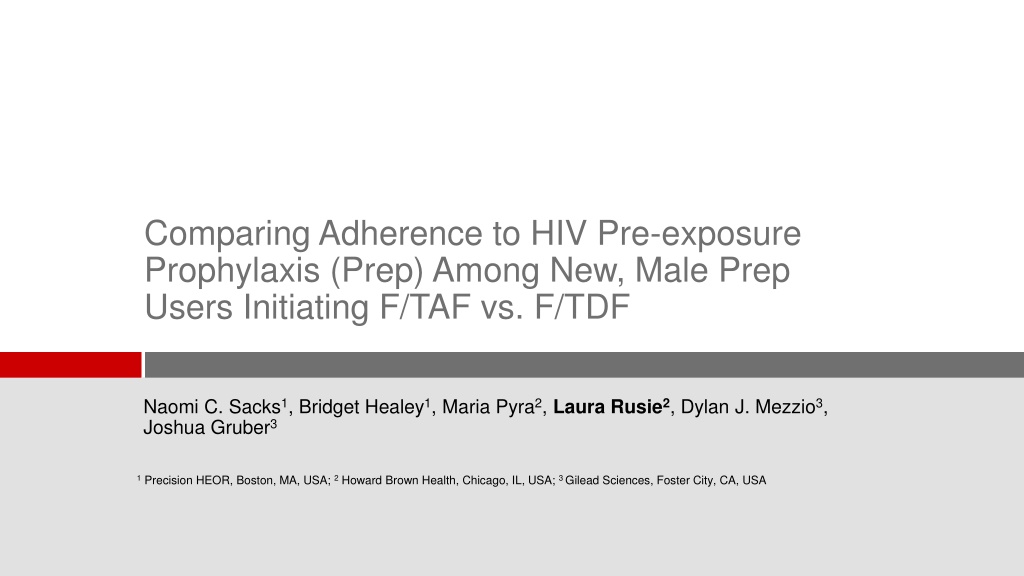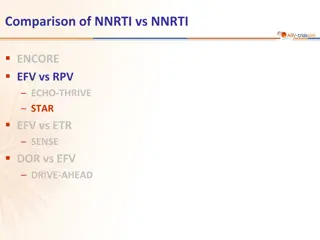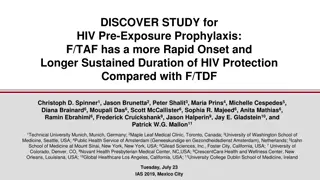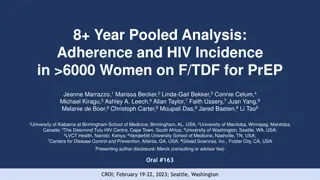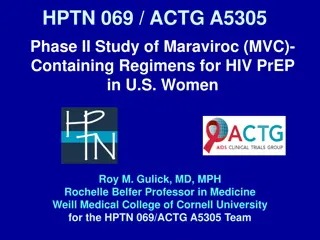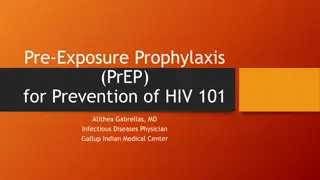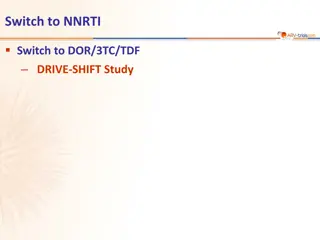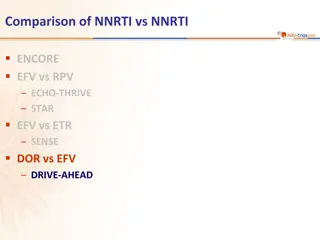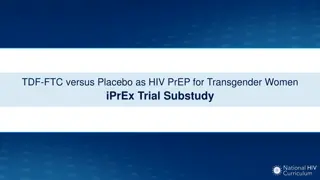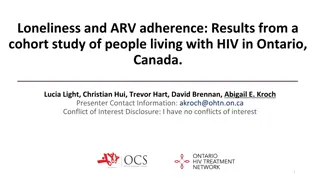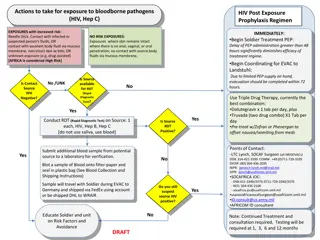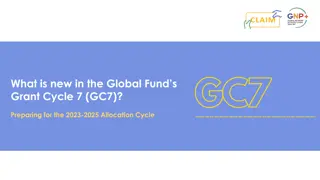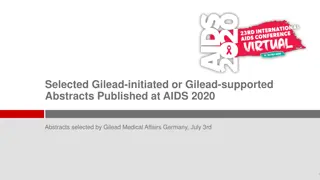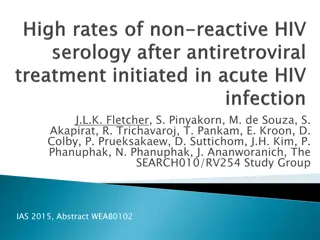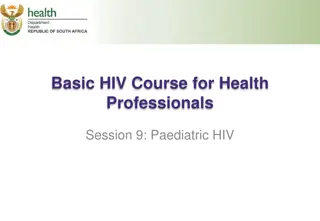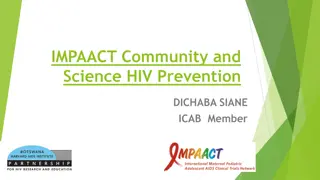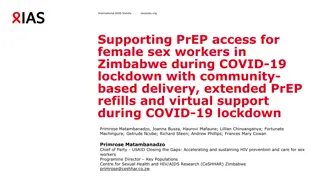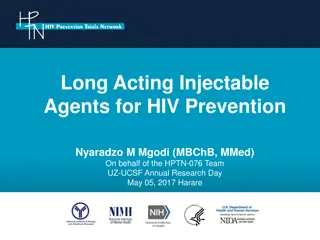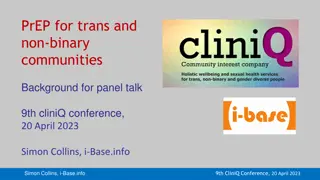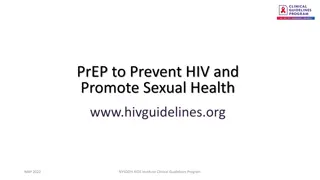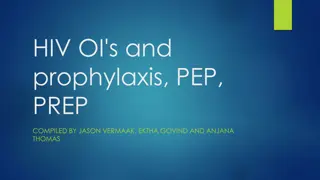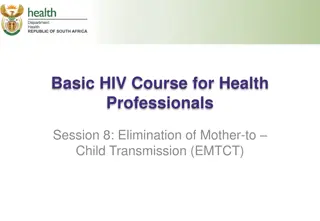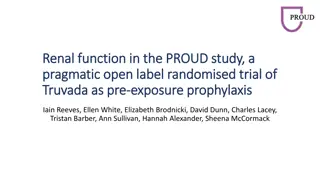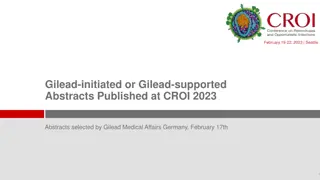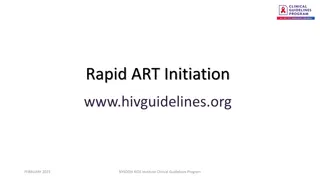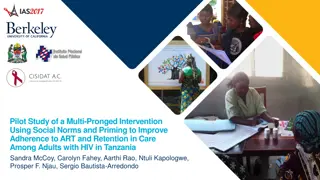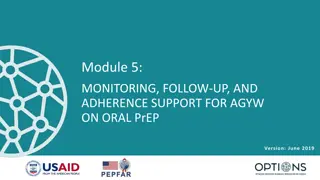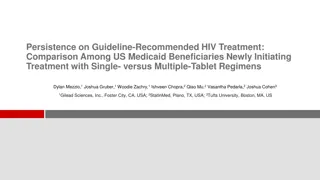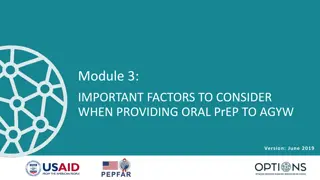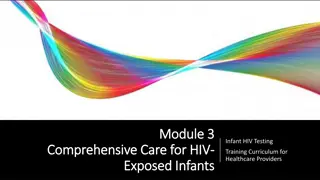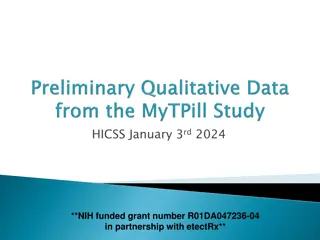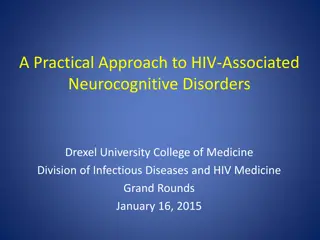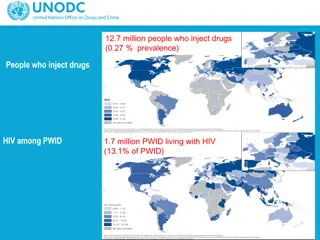Comparing Adherence to HIV Pre-exposure Prophylaxis (PrEP) Among New Male PrEP Users Initiating F/TAF vs. F/TDF
This study aims to describe real-world use patterns and HIV seroconversion rates for individuals using emtricitabine/tenofovir disoproxil fumarate (F/TDF) vs. emtricitabine/tenofovir alafenamide (F/TAF) as pre-exposure prophylaxis (PrEP) for HIV prevention. The retrospective analysis includes newly initiated male adult users of either regimen and evaluates adherence through proportion of days covered (PDC) and HIV seroconversion rates. Differences are examined through statistical analysis methods, controlling for variables like age, geography, and insurance type.
Download Presentation

Please find below an Image/Link to download the presentation.
The content on the website is provided AS IS for your information and personal use only. It may not be sold, licensed, or shared on other websites without obtaining consent from the author. Download presentation by click this link. If you encounter any issues during the download, it is possible that the publisher has removed the file from their server.
E N D
Presentation Transcript
Comparing Adherence to HIV Pre-exposure Prophylaxis (Prep) Among New, Male Prep Users Initiating F/TAF vs. F/TDF Naomi C. Sacks1, Bridget Healey1, Maria Pyra2, Laura Rusie2, Dylan J. Mezzio3, Joshua Gruber3 1 Precision HEOR, Boston, MA, USA; 2 Howard Brown Health, Chicago, IL, USA; 3 Gilead Sciences, Foster City, CA, USA
Objective and Background Objective: Describe real-world use patterns and HIV seroconversion for F/TAF and F/TDF Background: Pre-exposure prophylaxis (PrEP) is effective at preventing HIV Two approved and highly effective PrEP regimens: Emtricitabine/tenofovir disoproxil fumarate (F/TDF) Emtricitabine/tenofovir alafenamide (F/TAF) Limited, contemporaneous real-world data on adherence and HIV seroconversion comparing F/TAF to F/TDF 2
Methods: Study Design Retrospective analysis of PurpleLab unadjudicated claims data Medical and pharmacy claims (all U.S. payer types) Eligible PrEP users: Male, Adult ( 18 years) Newly Initiated F/TDF or F/TAF Index period: OCT 01,2019 through JAN 31, 2020 No history of PrEP medication use prior to index (from OCT 01, 2015) Existing enrollment ( 1 medical claim 30day prior to index) Exclusions: Evidence of Dx or Tx for HIV or HBV (-12 months to +30 day of index) Evidence of PEP in prior 30days Included users followed for minimum of 240 day Outcome measures reported at 180, 210 and 240 day 3 Abbreviations: PrEP: Pre-exposure prophylaxis; HBV: Hepatitis B; Dx: medical diagnosis; Tx: treatment; PEP: post-exposure prophylaxis
Methods: Outcomes and Analysis Outcomes: Proportion of days covered (PDC) Total number of days of PrEP supply/calendar days observed Prescription Adherence PDC 0.8 HIV Seroconversion: Medical claim for HIV Dx or Evidence of ART Rx for Tx (added 3rd agent or full regimen) Analysis: Differences in proportions/means: Chi-square and t-tests Multivariable regression (logistic and proportional hazards) Controllingfor: age group, geography and type of insurance 4 Abbreviations: PrEP: Pre-exposure prophylaxis; Dx: medical diagnosis; ART: anti-retroviral treatment; Rx: prescription claim; Tx: treatment
Results: Sample and Cohorts Attrition table for identifying patients (1/28/2021) F/TAF F/TDF Patient s first observable filled PrEP Rx with F/TAF or F/TDF ever occurs between October 1, 2019 and January 31, 2020 7,919 14,158 Age 18 or older at index Rx 7,885 13,912 No indication of HIV or no indication of HBV treatment any time before index or up to 30 days after 4,869 9,962 Patient is male 4,615 8,193 Patient DOES NOT have HIV Dx in 365 days prior or 30 days after index 4,561 8,153 Patient DOES NOT have HBV Dx in 365 days prior or 30 days after index 4,559 8,140 Patient DOES NOT have HIV comorbid Dx in 365 days prior or 30 days after index 4,557 8,133 Patient DOES NOT have PEP Dx in 30 days prior to index 4,552 8,122 Patient has at least 30 days supply on index prescription, or 30-day continuous supply with no gaps larger than 14 days to start 4,546 8,066 At least 1 medical claim in 30 days prior to index 1,107 1,935 PrEP Cohorts F/TAF F/TDF Analytic Sample 1,107 1,935 Abbreviations: PrEP: Pre-exposure prophylaxis; Dx: medical diagnosis; ART: anti-retroviral treatment; Rx: prescription claim
Results: Cohort Comparison Demographic categories F/TAF F/TDF Index Characteristics Patient count 1,107 1,935 F/TDF users: Skew younger More likely from NE; less likely from MW Potential differences in insurance coverage Age: mean SD 38.4 12.64 35.4 12.31 Age: Median (IQR) 35 (18) 32 (16) Age: 18-24; n (%) 114 (10%) 342 (18%) Age: 25-44; n (%) 679 (61%) 1167 (60%) Age: 45-64; n (%) 273 (25%) 369 (19%) Age: 65+; n (%) 41 (4%) 57 (3%) Region: Northeast; n (%) 254 (23%) 582 (30%) Post-Index Characteristics Region: Midwest; n (%) 129 (12%) 303 (16%) Region: South; n (%) 365 (33%) 540 (28%) No differences in likelihood of Dx and Rx claims HIV screening claim more likely with F/TAF Non-PrEP Rx more likely in F/TDF Region: West; n (%) 359 (32%) 510 (26%) Payer: Medicare only; n (%) 23 (2%) 54 (3%) Payer: Medicaid only; n (%) 46 (4%) 127 (7%) Payer: Commercial only; n (%) 880 (79%) 1455 (75%) Payer: Other only; n (%) 29 (3%) 43 (2%) Payer: Unknown; n (%) 92 (8%) 195 (10%) Payer: Dual coverage; n (%) 37 (3%) 61 (3%) 6 Abbreviations: PrEP: Pre-exposure prophylaxis; Dx: medical diagnosis; Rx: prescription claim
Results: Mean PDC and Adherence F/TAF users had higher measures of PrEP prescription adherence at 180, 210 and 240 days - compared to F/TDF users Difference in proportion of PrEP users with PDC 0.80 Mean PDC by Cohort Chi-Square p-value F/TAF PDC .80 F/TDF PDC .80 Chi-Square p-value Follow up period F/TAF F/TDF Follow up period 0.65 0.57 <0.0001 525 (47%) 643 (33%) <0.0001 180 days 180 days 0.62 0.53 <0.0001 482 (44%) 589 (30%) <0.0001 210 days 210 days 0.58 0.50 <0.0001 400 (36%) 444 (23%) <0.0001 240 days 240 days In multivariable analyses: At 180 days, F/TAF users had 1.67 higher odds (95% CI: 1.43, 1.95) of adherence relative to F/TDF - after controlling for age, region and type of insurance 7 Abbreviations: PrEP: Pre-exposure prophylaxis; PDC: proportion of days covered
Results: Seroconversion Percent of people with HIV seroconversion stratified by PrEP treatment F/TDF F/TAF 1.71% 1.71% 1.80% Percent of people with incidence case 1.60% 1.60% F/TAF users were numerically less likely to seroconvert at all time points (cumulative incidence) 1.45% 1.36% 1.40% 1.26% 1.20% 1.00% 0.80% 0.60% F/TAF user had lower rates of seroconversion when including all available observation time (up to 360 days) 0.40% 1.20% 0.00% 180 days 210days 240days Reduced seroconversion proportions and rates among F/TAF users were not statistically different Incidence per 100 patient years IRR (95% CI) (F/TAF)/(F/TDF) Seroconversion F/TAF F/TDF IRR 95% CI All Available Observation Time 1.58 1.95 0.807 (0.485,1.713) 8 Abbreviations: IRR: incidence rate ratio; CI: confidence interval
Limitations and Conclusions Limitations Real world, unadjudicated claims data. Limited power: follow-up time, sample. Conclusions These are the first data comparing F/TAF to F/TDF over concurrent time periods. These data suggest that people who may benefit from PrEP were more adherent to F/TAF when compared to F/TDF over the same time period. At 6-months, adjusted odds of prescription adherence to PrEP was 1.7 times greater among F/TAF users, compared to F/TDF users. Reductions are consistent across all time points (PDC and adherence). F/TAF showed a numerically lower rate of seroconversion at all time points compared to F/TDF but was not powered for statistical significance. Results suggest additional work is needed to understand reasons for differences in prescription adherence and its relationship to HIV seroconversion. 9
